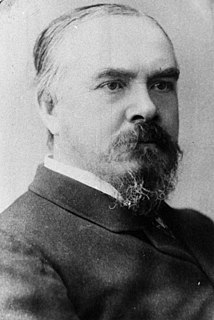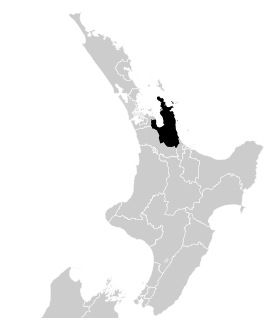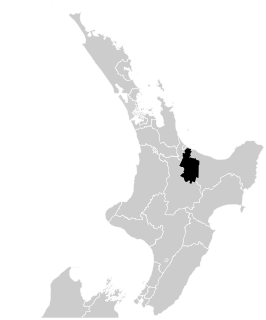Related Research Articles

The 1881 New Zealand general election was held on 8 and 9 December in the Māori and European electorates, respectively, to elect 95 MPs to the 8th session of the New Zealand Parliament.

The 1890 New Zealand general election was one of New Zealand's most significant. It marked the beginning of party politics in New Zealand with the formation of the Liberal Government, which was to enact major welfare, labour and electoral reforms, including giving the vote to women.

Coromandel is a New Zealand electoral division returning one member to the House of Representatives. It is currently represented by Scott Simpson, a member of the National Party.
Piako was a New Zealand parliamentary electorate established in 1946 and disestablished in 2008. It was last held by Lindsay Tisch MP from 2002 to 2008.

Rotorua is a New Zealand parliamentary electorate, returning one Member of Parliament to the New Zealand House of Representatives. It was first established in 1919, and has existed continuously since 1954. The current MP for Rotorua is Todd McClay of the National Party, who won the electorate in the 2008 general election from incumbent Labour MP Steve Chadwick.
Raglan is a former New Zealand parliamentary electorate. It existed for three periods between 1861 and 1996 and during that time, it was represented by 13 Members of Parliament.
Franklin was a rural New Zealand parliamentary electorate. It existed from 1861 to 1996 during four periods.
Bay of Islands is a former New Zealand parliamentary electorate. It existed during various periods between 1853 and 1993. It was thus one of the original 24 electoral districts, and New Zealand's first ever MP was elected, although unopposed, in the Bay of Islands; Hugh Carleton thus liked to be called the Father of the House.
Ohinemuri is a former New Zealand parliamentary electorate. It existed from 1896 to 1928, and was represented by five Members of Parliament.
Timaru was a parliamentary electorate, in New Zealand's South Island. It existed continuously from 1861 to 1996 and was represented by eleven Members of Parliament.
Inangahua is a former parliamentary electorate in the Buller District, which is part of the West Coast region of New Zealand, from 1881 to 1896. The town of Inangahua Junction, which gave the electorate its name, was located in the adjacent Buller electorate until 1887.
Waitomo was a parliamentary electorate in the Waikato region and the King Country of New Zealand, from 1919 to 1972. The electorate was represented by four Members of Parliament.
Te Aro was a parliamentary electorate in Wellington, New Zealand from 1881 to 1890. It covered the southern area of the central business district. During the three parliamentary terms of its existence, the electorate was represented by three Members of Parliament.
Christchurch was a parliamentary electorate in Christchurch, New Zealand. It existed three times. Originally it was the Town of Christchurch from 1853 to 1860. From the 1860–1861 election to the 1871 election, it existed as City of Christchurch. It then existed from the 1875–1876 election until the 1881 election. The last period was from the 1890 election to the 1905 election. Since the 1946 election, a similarly named electorate called Christchurch Central has been in existence.
Halswell was a parliamentary electorate in Christchurch, New Zealand from 1890 to 1893. It was represented by one Member of Parliament during that time.
Ellesmere was a parliamentary electorate in the Canterbury region of New Zealand. It existed for two periods between 1861 and 1928 and was represented by six Members of Parliament.
Taumarunui was a parliamentary electorate in the King Country in the Manawatū-Whanganui region of New Zealand from 1908 to 1919. The electorate was represented by two Members of Parliament.

William Fraser (1827–1901) was a 19th-century Liberal Party Member of Parliament in the Auckland Region, New Zealand.

The 11th New Zealand Parliament was a term of the Parliament of New Zealand.

The 1891 Te Aroha by-election was a by-election held on 9 July 1891 during the 11th New Zealand Parliament in the Waikato electorate of Te Aroha. The 1890 general election in the Te Aroha electorate had been contested by William Shepherd Allen and William Fraser. Allen was elected, but Fraser mounted a successful election petition, and Allen was disqualified from standing again. The by-election was contested by Fraser and Sir Walter Buller, the well known ornithologist, who both represented the Liberal Party, plus a third candidate who was not taken seriously. Shortly before the election, the Liberal Government made Fraser its official candidate. A candidate representing the opposition pulled out of the contest in late June, as it was clear that only a Liberal Party supporter could win. Fraser won the by-election, obtaining more than 60% of the votes.
References
- McRobie, Alan (1989). Electoral Atlas of New Zealand. Wellington: GP Books. ISBN 0-477-01384-8.
- Wilson, James Oakley (1985) [First published in 1913]. New Zealand Parliamentary Record, 1840–1984 (4th ed.). Wellington: V.R. Ward, Govt. Printer. OCLC 154283103.